JAMO C 803 User Manual [en, de, es, fr, it]

OWNER´S MANUAL
Jamo C 80

english
français
deutsch
dansk
svenska
suomi
español
italiano
nederlands
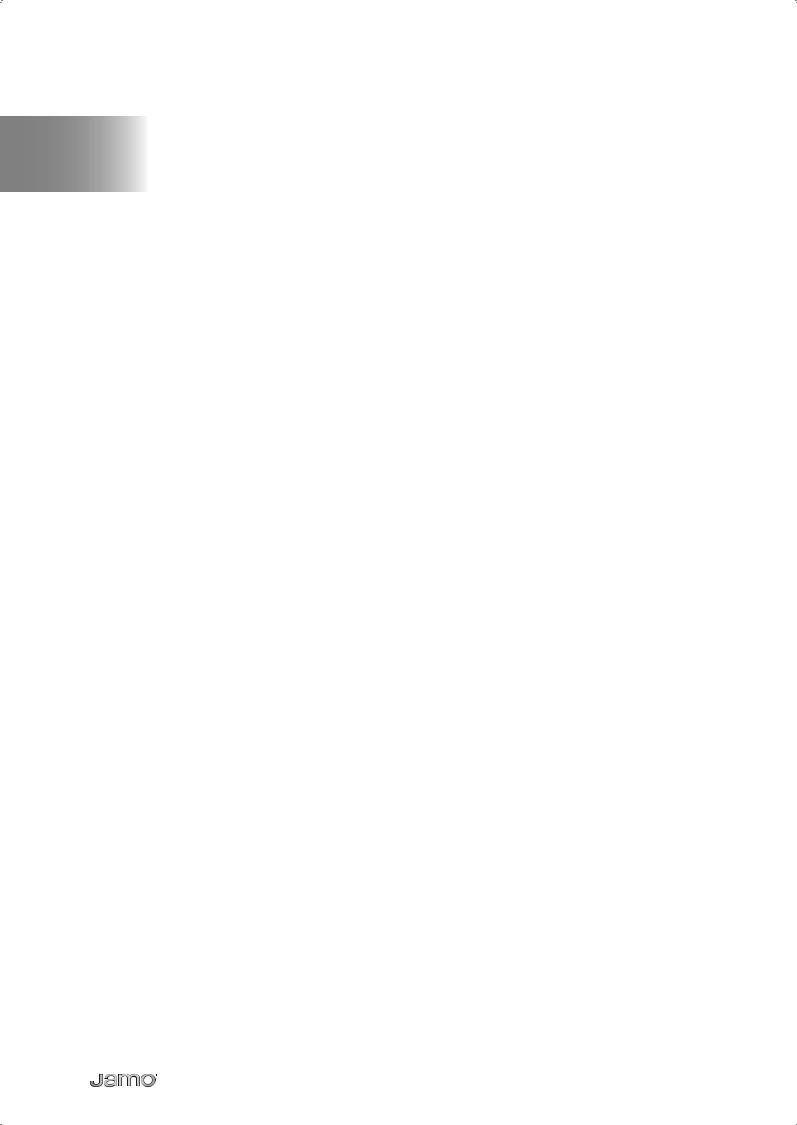
english
Contents |
|
Introduction ..................................................................................................................................... |
5 |
General tips for setting up speakers......................................................................................... |
6 |
Connecting........................................................................................................................................ |
8 |
Spikes................................................................................................................................................... |
9 |
C 803 / C 805 / C807 / C809 ....................................................................................................... |
10 |
C 80 CEN ........................................................................................................................................... |
11 |
C 80 SUR............................................................................................................................................ |
12 |
C 80 SUB............................................................................................................................................ |
14 |
Connecting the subwoofer........................................................................................................ |
15 |
Speaker level input terminals ................................................................................................... |
16 |
Subwoofer adjustment options............................................................................................... |
17 |
Cleaning............................................................................................................................................ |
19 |
Specifications.................................................................................................................................. |
20 |
Jamo consumer warranty........................................................................................................... |
21 |
4
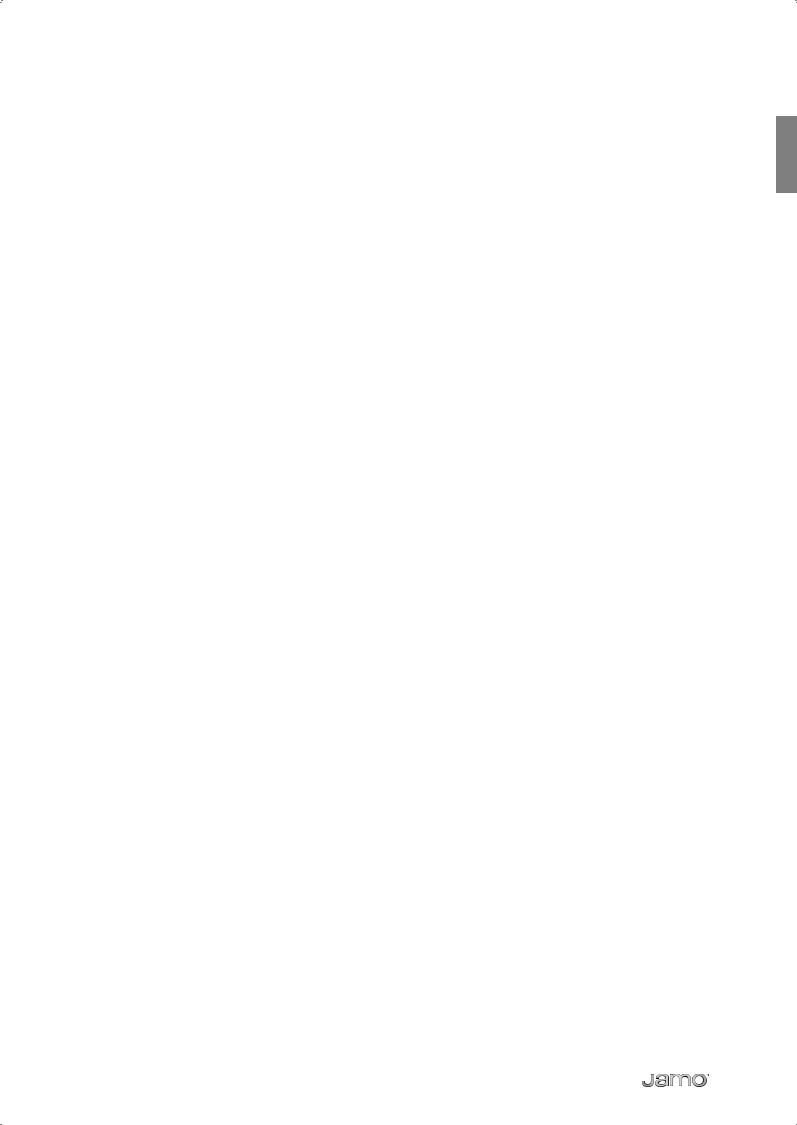
Introduction
Welcome to the exclusive circle of Jamo C 80 owners! This manual will give you a quick overview of how to set up your speakers in your room. For more in-depth information about the technologies used please refer to the C 80 technical description and www.Jamo.com.
First, a word of advice. After setting up your speakers for the first time, please allow at least a couple of days before you start fine-tuning the sound. This will serve two purposes. Firstly, you will get a sense of what these speakers sound like. Secondly, it will give time for the speakers to run in: the tonal quality of this design changes slightly after the first couple days of playing music.
Please remember the guidelines in this manual are only recommendations. There are no hard and fast rules about setting up a pair of speakers. When you get down to fine-tuning their performance in your room don’t be afraid of experimenting: any speaker will sound different when moved a few inches. Feel free to change the speaker positions and move them around the room to determine your best listening position and sound.
Always rely on your own judgement to determine what sounds best.We do...
Enjoy!
5
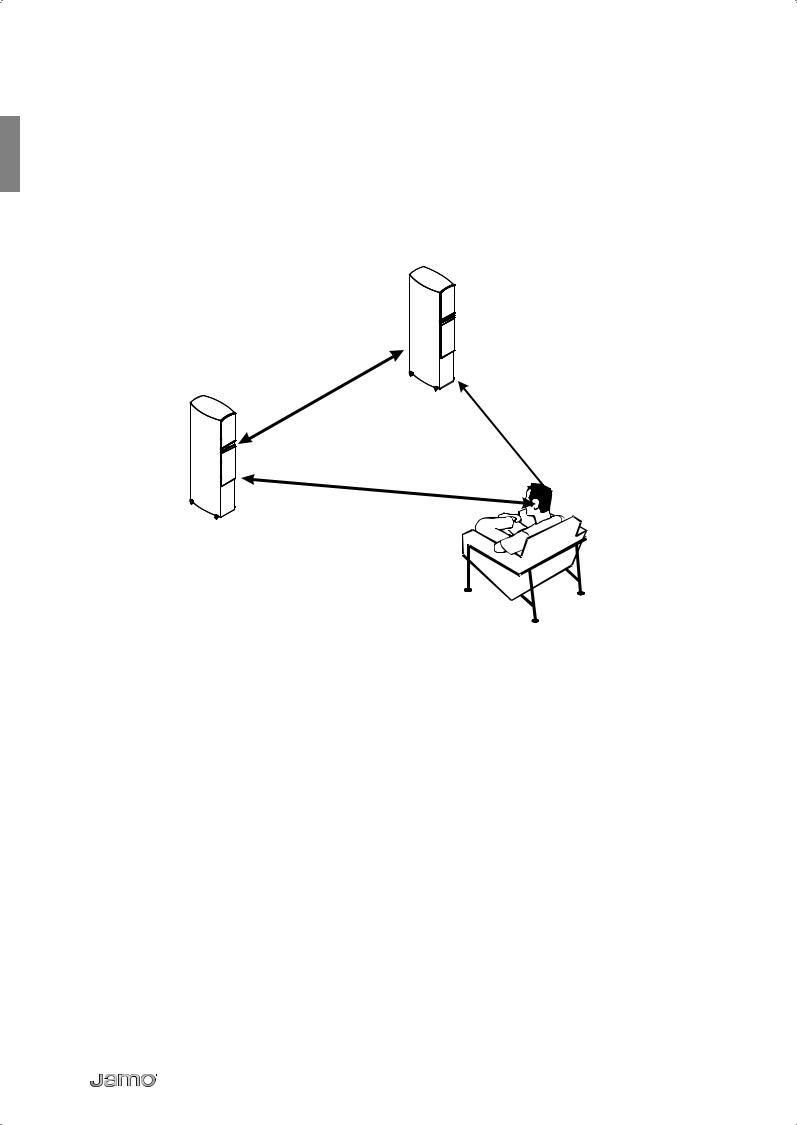
General tips for setting up speakers
Stereo triangle
You can use the stereo triangle as a good rule of thumb when placing your speakers. This means the distance between the speakers should be the same as the distance from your listening position to both speakers; in other words an equilateral triangle.
Damping
If your room…
a)doesn’t allow you to get the speakers the required distance from the back and side walls or…
b)has highly reflective surfaces (i.e. glass windows or bare plastered walls) or…
c)still doesn’t sound quite right
…we strongly recommend that you ‘damp’ your room’s critical surfaces. This can be done simply by adding curtains, furniture, bookshelves and so on. A damped surface is almost always preferable to a hard reflective surface.
Depending on the placement of the speakers, room size, sound reflecting surfaces, furniture, etc, it is entirely up to you how you fine-adjust the placement, angling and damping. Remember to take your time and use your ears.
6
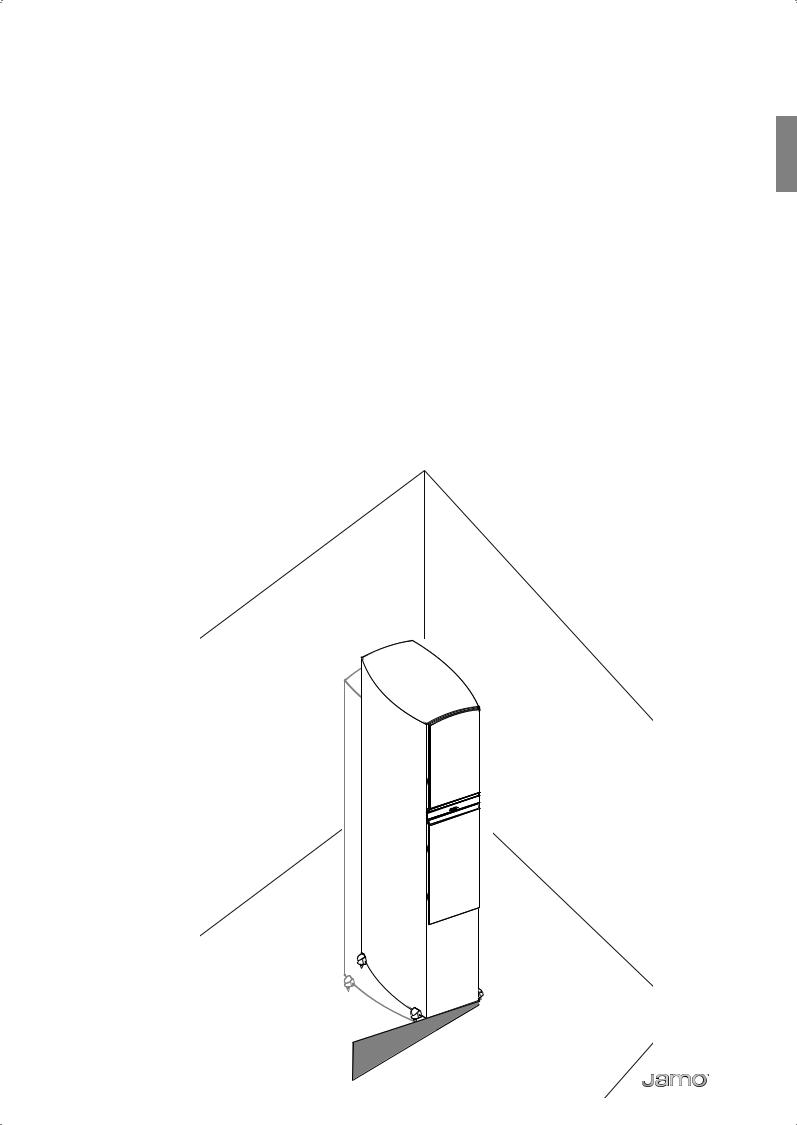
Toe-in
To achieve optimal sound, try experimenting with ‘toeing in’ the speakers towards the listening position.This achieves two things:
a)Fine-tuning of the tweeter level, which is more sensitive to reflections than midrange and bass output, treble is more directive than midrange and bass frequencies.
b)Secondly you minimize side-wall reflections, thereby reducing colouration of the sound.
Some may not feel a need to toe in the speakers at all, while others may find the best solution is to point them directly at the listening position. See what suits you best…
7

Connecting
The C 803, C 805, C 807 and C 809 speakers comes prepared for bi-wiring. Please note the following three possible setups.
Single-wiring
For single-wire connections, the terminal jumpers should be attached as shown in the illustration.
AMPLIFIER
Bi-wiring
If you’d like to use a bi-wiring arrangement, make sure you remove both the terminal jumpers before you connect up your loudspeaker cables like so…
AMPLIFIER
Bi-amping
In a bi-amped system, make sure you remove both the terminal jumpers before connecting up your cables as shown.
If you choose this option, we recommend you use identical amplifiers to drive both the bass and treble units.
AMPLIFIER 1 |
AMPLIFIER 2 |
8

Spikes
After the initial placement of the C 80 floorstanders, you might consider using the supplied spikes instead of the built-in rubber feet. To fix them on, we recommend that you gently lay the speaker on one side and screw in all four spikes together. Before you do this, however, be sure to place a couple of thick towels or similar underneath the side of the speaker. This will prevent accidental scratching to the surface of the speaker.
2
1
After screwing in the spikes, gently bring the speaker to its vertical position. Once upright simply adjust the spikes to give optimal support.
Using the spikes will give the very best support and sound quality. If you want to spare your floor surface from being punctured however, you can place the indented metal washers underneath the spike.
A warning: be careful when using the spikes with the indented metal washers – you don’t want to get your finger trapped between the two!
Whichever option you choose, avoid “walking” the speakers if you need to move them to a different position… especially on hard wood floors!
9
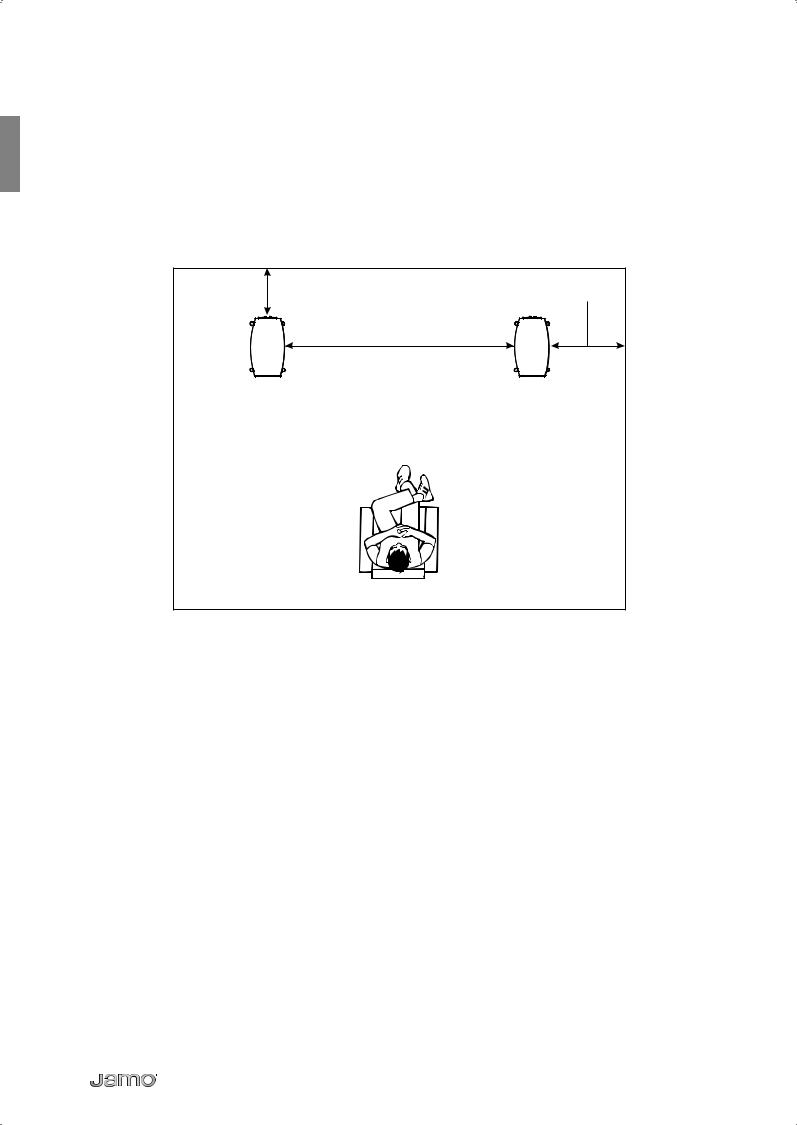
C 803 / C 805 / C 807 / C 809
Placement
For an optimal listening experience, we recommend you place these speakers a minimum of 2m/6ft from each other, a minimum of 0.5m/1.5ft from the back wall and at least 1m/3ft from any side walls.
-INM FT |
-INM M FT |
-IN FT |
|
10
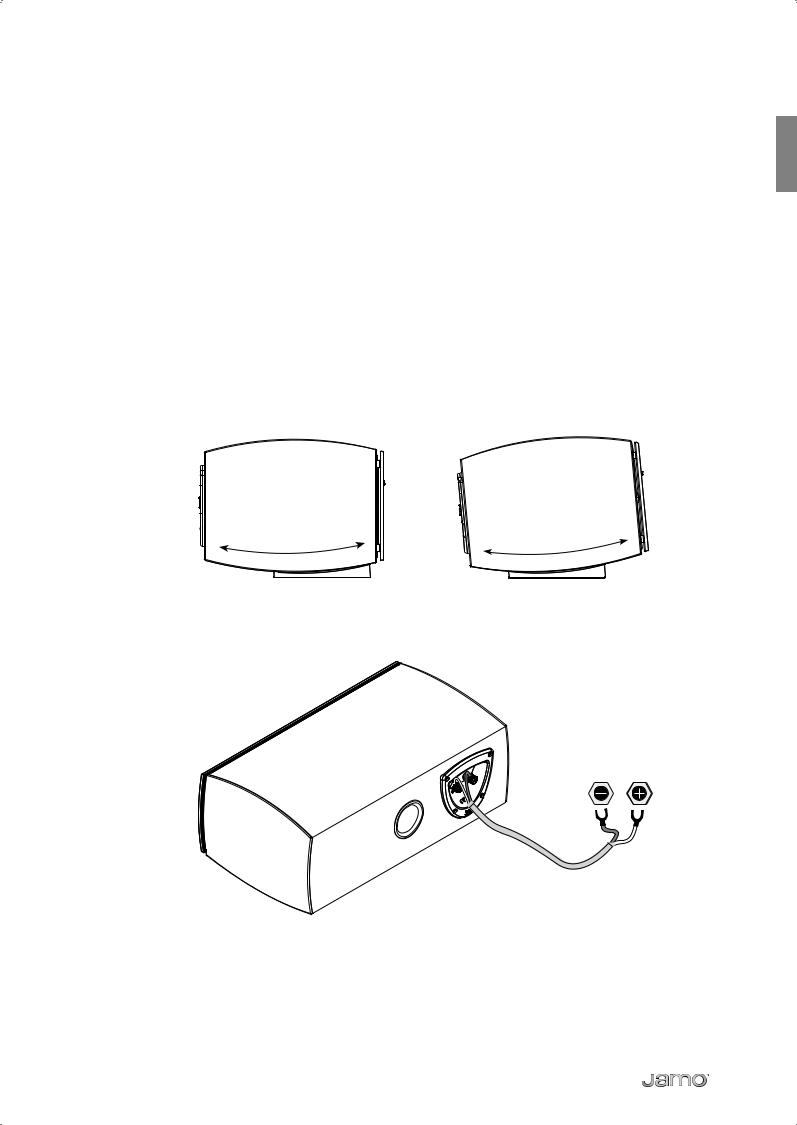
C 80 CEN
Placement
For an optimal listening experience, we recommend you place the C 80 CEN close to your screen, either just above or just below it.The speaker is magnetically shielded so it can be placed close to a normal CRT-type TV.
Make sure the C 80 CEN stand/cradle is as stable as possible to ensure the optimal sound from the C 80 CEN.
Angling
To achieve optimal sound, the included speaker cradle is constructed in such a way that you can angle the C 80 CEN directly towards your listening position.Try experimenting with different angles until you are fully satisfied.
Connecting
Amplifier
11

C 80 SUR
Placement
The C 80 SUR are best placed at a 20 degree angle from the listening position and at a height of approximately 2m/6ft.
Connecting
Amplifier
12

6.1 and 7.1 setup
If you want to have a 6.1 surround setup, we recommend using an additional C 80 SUR (left) speaker. Place it right between the two side walls just behind your listening area, to achieve optimal sound.
In a 7.1 setup, use a pair of C 80 SUR and place them 1/4 of the full room width from each sidewall.
Note: when placing the C 80 SUR as surround back speakers, you must place the C 80 SUR (left) on the right side of the room, and vice versa for the other speaker, in order to achieve correct dispersion from the dipole speakers.
13
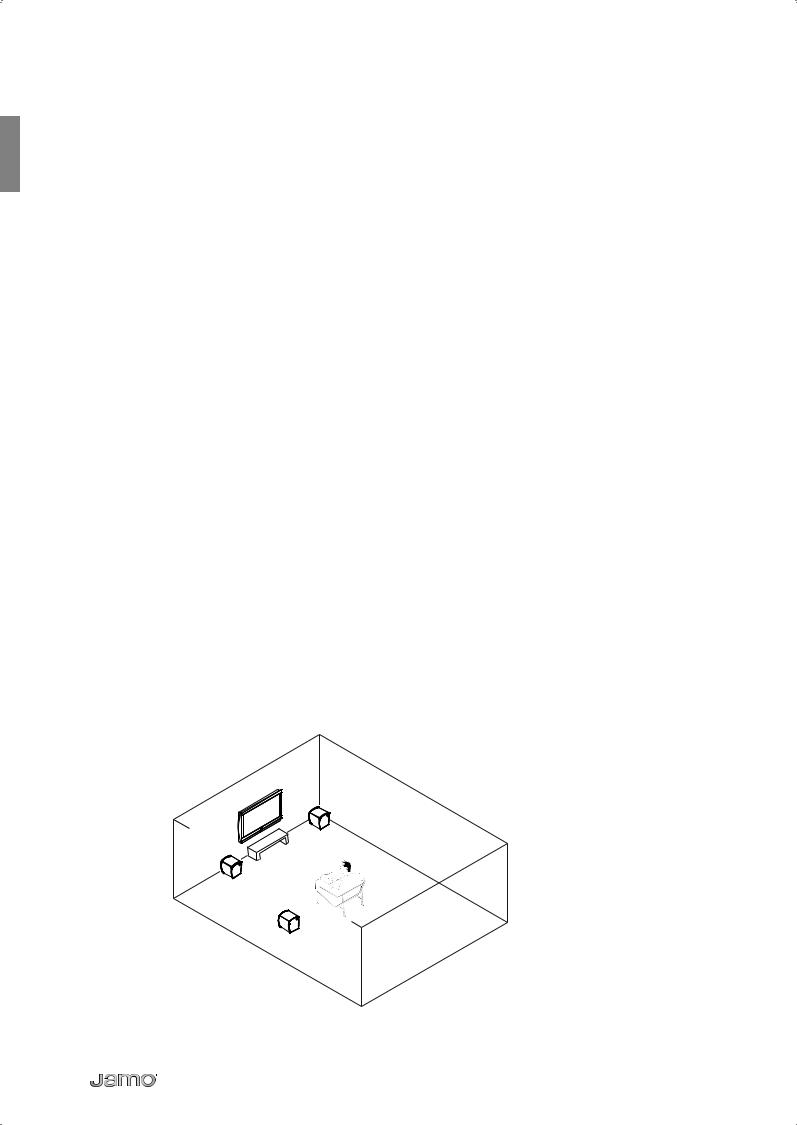
C 80 SUB
If you go to www.Jamo.com or look at the CD-rom which came with the product, you can find a couple of useful subwoofer test signals. These will help you to set up your subwoofer so it delivers the maximum performance. Burn the test signals onto a CD and put them in your CD/DVD player.
Placement rules for subwoofers
When placing a subwoofer in a room, you have more freedom than you would with an ordinary speaker because a sub generates less-directional low frequencies, which make it harder for the human ear to determine the direction they are coming from. We do still recommend, however, that you place the C 80 SUB mid-way between the two front speakers if possible.This is because:
A). The C 80 SUB will be easier to align, both leveland phase-wise, with the speakers.
B). Even though low frequencies are less-directional, higher frequencies can make the subwoofer easier to pinpoint sonically.
If it isn’t possible to place the C 80 SUB between the two front speakers, the advanced electronics provided in the subwoofer still makes an easy and seamless integration possible.
Three different placement positions - sound reflections and amplification
There are basically three different ways to place a subwoofer, either of which will affect the overall sound level.
A). Placing it away from any wall will give the lowest sound level, but typically the most linear frequency response.
B). Placing it next to a wall will increase the low frequency level.
C). If it is positioned up against two walls, i.e. in a corner, the subwoofer will - because of wall reflections - accentuate the low frequencies even more.
$
#
" |
14
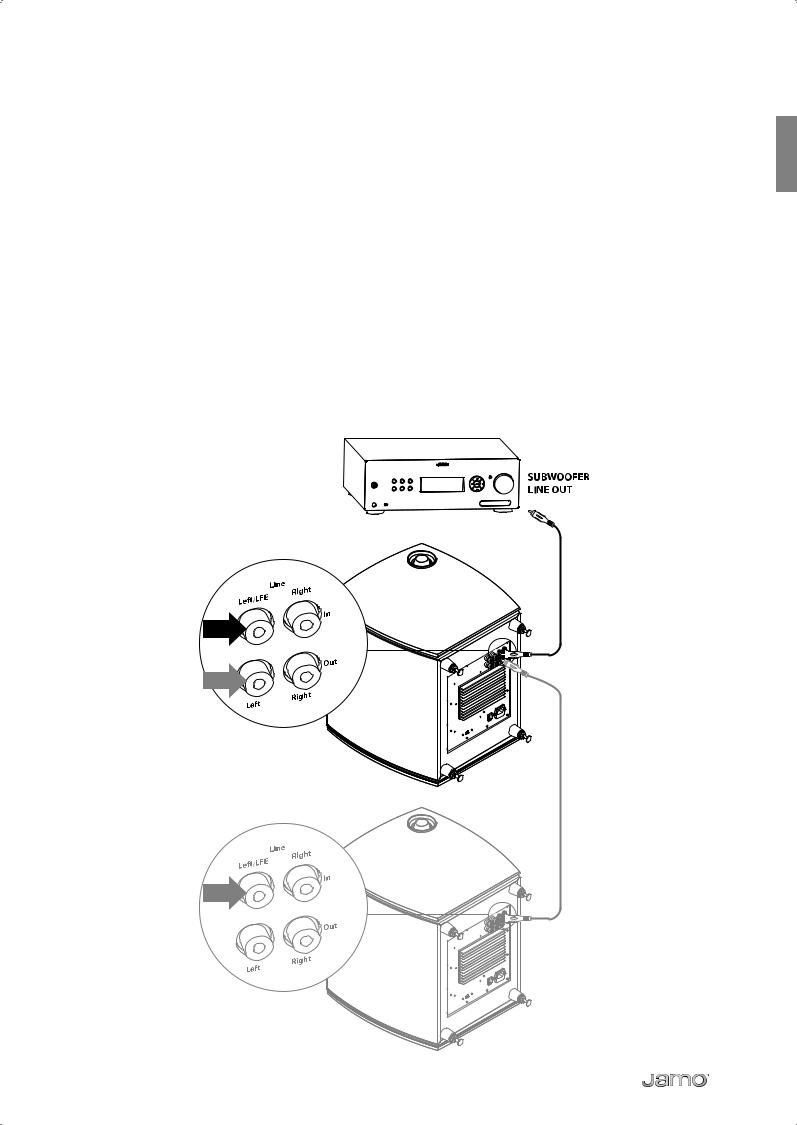
Finding the right place for your subwoofer
Irrespective of the location you choose for the subwoofer, it is essential to have as linear a frequency response as possible.There should, in other words, be as few dips and peaks in the response as possible.
When evaluating the best location for the subwoofer, listen to some music or test tones from your favourite listening position,then try to move the subwoofer around the room to find the location that best suits your personal preference.
Connecting the subwoofer
Line/LFE input terminals
If your preamp/amplifier has a subwoofer out or subwoofer LFE out,please connect it to the LFE input terminal on the C 80 SUB.
If you have an additional subwoofer, it is possible to connect it via the C 80 SUB’s LFE output terminal.
15
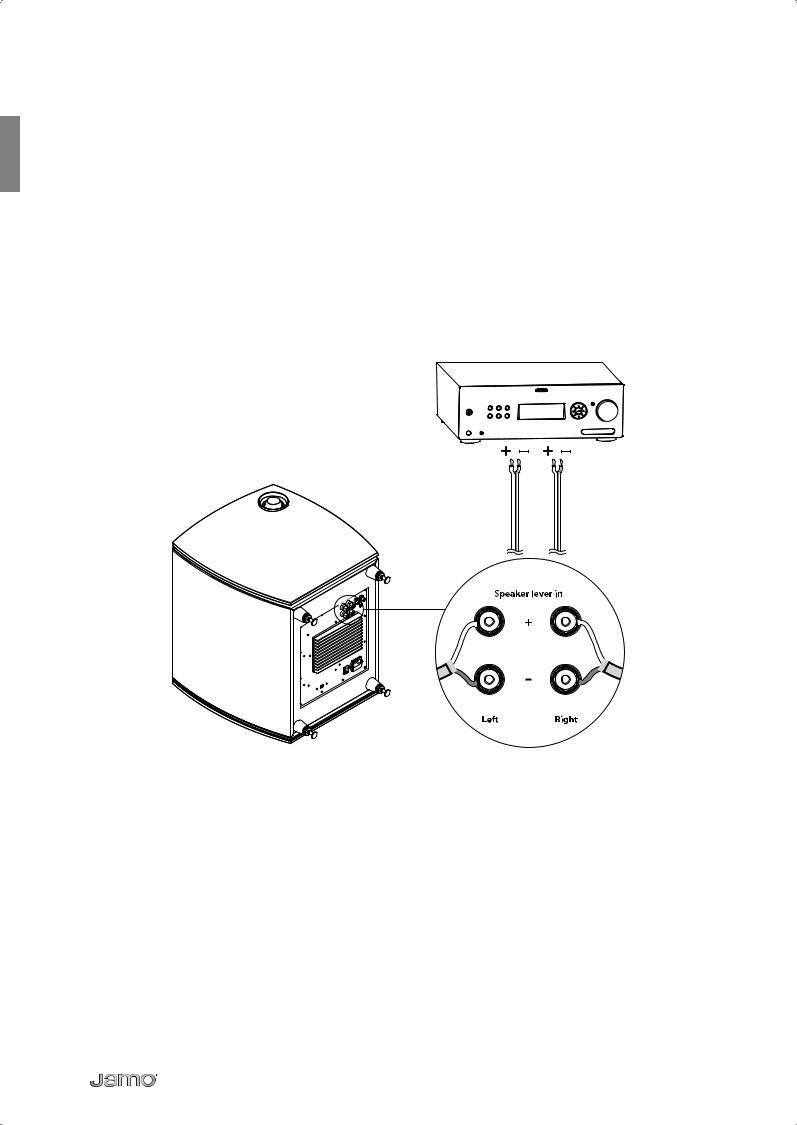
Speaker level input terminals
If you don’t have a subwoofer out, you can connect the amplifier’s speaker output directly to the speaker-level input terminals on the C 80 SUB.
Remember to connect both the left and right speaker outputs from the amplifier to the left and right input if you have just the one subwoofer connected. If only one channel is hooked up, the C 80 SUB will only reproduce the low frequencies contained in that channel.
Always remember to connect ”+” and ”-” from the amplifier to the corresponding ”+” and ”-” terminals on the subwoofer speaker level input.
16
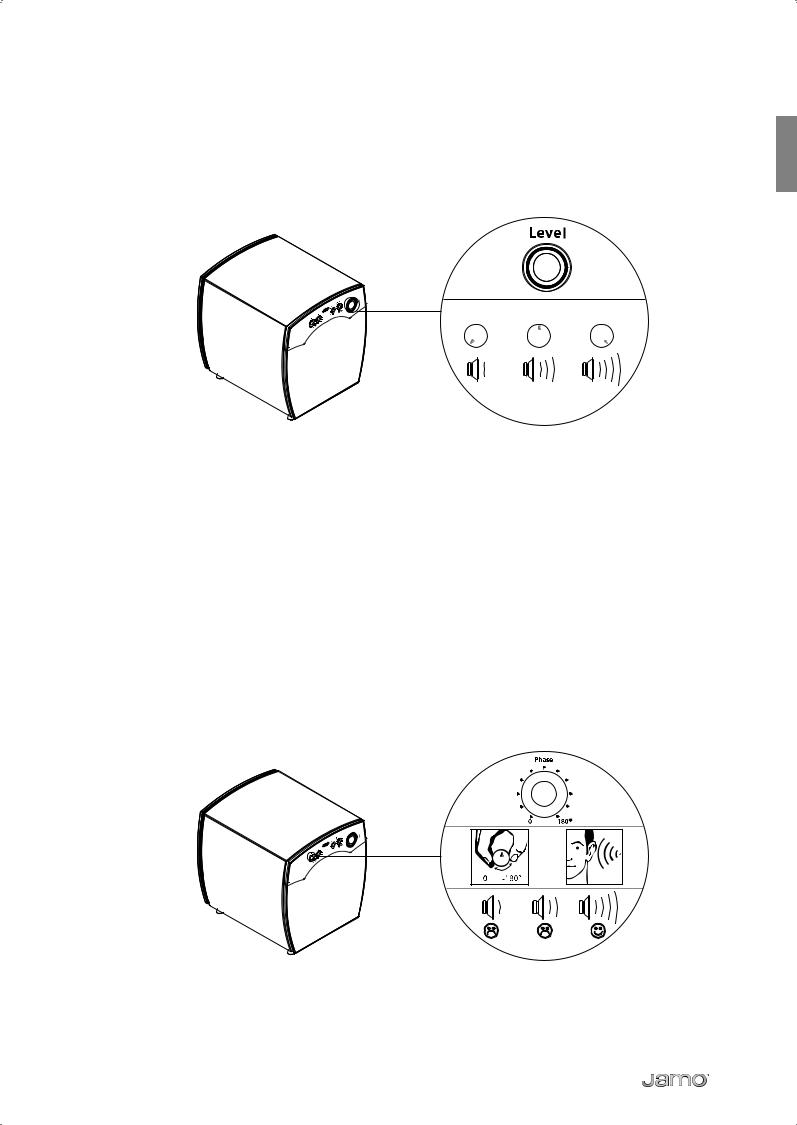
Subwoofer adjustment options
Level
The level control on the C 80 SUB controls the volume.
Phase
When all the speakers in your system and the subwoofer have been connected it is very important you have them connected in phase.
It is easier to adjust the phase on the subwoofer if you have someone helping you. Sit in the listening area and ask your helper to turn the phase control while you’re playing back bass-heavy music or the test frequency files found at www.Jamo.com or on the CD-rom which came with the product.Turn the control back and forth to determine the position where the overall bass level sounds the loudest; that’s when you’ll know the subwoofer is in correct phase.
Note that it may help to turn the volume of the subwoofer up when correcting the phase. Regardless, you may also need to turn the subwoofer volume down after finding the correct phase position, as it increases the overall bass output from the subwoofer.
17

Cut-off frequency
If the C 80 SUB is connected via an unfiltered output signal, such as a line pre-out or speaker output, it is necessary to adjust the cut-off frequency on the subwoofer to match the bass response of your speakers. If it is connected via a filtered output signal, such as a LFE or ‘subwoofer out’, the cut-off frequency should be turned all the way up, in order to stop the C 80 SUBs cut-off filter interfering with the filter built into your decoder/AV receiver.
Auto/On/Off
The Auto/on/off switch offers three settings:
Auto: The Subwoofer will automatically switch on when it detects a signal from the source, and switch into stand-by mode again 20 minutes after the signal has terminated.
On: The subwoofer will stay on
Off: The subwoofer will stay in stand-by mode
!54/ /. /&&
18

Variable Boundary Gain Compensation
Variable Boundary Gain Compensation is a filter which can compensate for bass peaking which typically starts around 60Hz and increases downwards. At first, this effect sounds superficially impressive, but listen to music for any length of time and it becomes“boomy”and rather annoying.The effect commonly occurs in smaller rooms and when your listening position is near to a wall, hence the name Boundary Gain Compensation.
As with phase adjustment, we recommend you play music or the test frequency files from www.Jamo.com and have a friend turn the Variable Boundary Gain Compensation control, while you sit in the listening area. Then simply adjust it so that when the bass hits the lowest frequencies, there aren’t any detectable bass peaks.
Cleaning
Please use a dust-free cloth to clean the speakers. It is also possible to use a slightly damp cloth for more stubborn marks.
Under no circumstances should you use any kind of cleaning agent on, or in close proximity to, these speakers.
19

Specifications |
|
Name................................................................................................... |
C 809 |
System............................................................................ |
3 way bassreflex |
Woofer (In / mm)...................................................................... |
2 x 7 / 180 |
Midrange (In / mm)....................................................................... |
7 / 180 |
Tweeter (In / mm)............................................................................. |
1 / 25 |
Long term power (W) ......................................................................... |
200 |
Short term power (W)......................................................................... |
400 |
Sensitivity (dB/2,8V/1 m) ..................................................................... |
89 |
Frequency range (Hz).............................................................. |
30-24000 |
Impedance (Ohm) .................................................................................... |
6 |
Crossover frequency (Hz) .................................................... |
150 / 2000 |
Dimensions HxWxD |
|
In......................................................................................... |
45.6 x 9.9 x 16.9 |
Mm................................................................................... |
1157 x 252 x 428 |
Name................................................................................................... |
C 807 |
System......................................................................... |
2½ way bassreflex |
Woofer (In / mm)............................................................................ |
7 / 180 |
Midrange (In / mm)....................................................................... |
7 / 180 |
Tweeter (In / mm)............................................................................. |
1 / 25 |
Long term power (W) ......................................................................... |
180 |
Short term power (W)......................................................................... |
360 |
Sensitivity (dB/2,8V/1 m) ..................................................................... |
89 |
Frequency range (Hz).............................................................. |
35-24000 |
Impedance (Ohm) .................................................................................... |
6 |
Crossover frequency (Hz) .................................................... |
150 / 2000 |
Dimensions HxWxD |
|
In......................................................................................... |
39.6 x 9.6 x 16.0 |
Mm................................................................................... |
1007 x 242 x 406 |
Name................................................................................................... |
C 805 |
System......................................................................... |
2½ way bassreflex |
Woofer (In / mm)............................................................................ |
6 / 155 |
Midrange (In / mm)....................................................................... |
6 / 155 |
Tweeter (In / mm)............................................................................. |
1 / 25 |
Long term power (W) ......................................................................... |
160 |
Short term power (W)......................................................................... |
320 |
Sensitivity (dB/2,8V/1 m) ..................................................................... |
88 |
Frequency range (Hz).............................................................. |
40-24000 |
Impedance (Ohm) .................................................................................... |
6 |
Crossover frequency (Hz) .................................................... |
150 / 2000 |
Dimensions HxWxD |
|
In......................................................................................... |
34.5 x 7.9 x 13.7 |
Mm..................................................................................... |
877 x 201 x 347 |
Name................................................................................................... |
C 803 |
System............................................................................ |
2 way bassreflex |
Woofer (In / mm)............................................................................ |
7 / 180 |
Midrange (In / mm)................................................................................... |
- |
Tweeter (In / mm)............................................................................. |
1 / 25 |
Long term power (W) ......................................................................... |
125 |
Short term power (W)......................................................................... |
250 |
Sensitivity (dB/2,8V/1 m) ..................................................................... |
87 |
Frequency range (Hz).............................................................. |
45-24000 |
Impedance (Ohm) .................................................................................... |
6 |
Crossover frequency (Hz) ............................................................... |
2000 |
Dimensions HxWxD |
|
In......................................................................................... |
15.0 x 8.9 x 13.4 |
Mm..................................................................................... |
380 x 225 x 341 |
Name............................................................................................ |
C 80 CEN |
System............................................................................ |
2 way bassreflex |
Woofer (In / mm)....................................................................... |
2 x 6 /155 |
Midrange (In / mm)................................................................................... |
- |
Tweeter (In / mm)............................................................................. |
1 / 25 |
Long term power (W) ......................................................................... |
160 |
Short term power (W)......................................................................... |
320 |
Sensitivity (dB/2,8V/1 m) ..................................................................... |
88 |
Frequency range (Hz).............................................................. |
80-24000 |
Impedance (Ohm) .................................................................................... |
6 |
Crossover frequency (Hz) ............................................................... |
2000 |
Dimensions HxWxD |
|
In........................................................................................... |
8.3 x 8.9 x 13.4 |
Mm..................................................................................... |
212 x 501 x 281 |
Name............................................................................................ |
C 80 SUR |
System.................................................................................... |
2 way dipole |
Woofer (In / mm)...................................................................... |
2 x 6 / 155 |
Midrange (In / mm)................................................................................... |
- |
Tweeter (In / mm)...................................................................... |
2 x 1 / 25 |
Long term power (W) ......................................................................... |
160 |
Short term power (W)......................................................................... |
320 |
Sensitivity (dB/2,8V/1 m) ..................................................................... |
87 |
Frequency range (Hz).............................................................. |
80-24000 |
Impedance (Ohm) .................................................................................... |
6 |
Crossover frequency (Hz) ............................................................... |
2500 |
Dimensions HxWxD |
|
In......................................................................................... |
11.5 x 11.3 x 7.1 |
Mm..................................................................................... |
293 x 286 x 181 |
Name............................................................................................ |
C 80 SUB |
System....................................................................................... |
Closed box |
Woofer (In / mm)................................................................... |
2 x 10 / 254 |
Amplifier rated output (W)............................................................ |
1800 |
Frequency range (Hz)........................................................... |
20 – 200Hz |
Cut off frequency (Hz)................................................................ |
Variable |
Impedance (Ohm) ................................................................................ |
22k |
Phase................................................................................................ |
Variable |
Boundary Gain Comp................................................................. |
Variable |
Limiter ...................................................................................................... |
Yes |
Auto/on/off switch............................................................................... |
Yes |
12V trigger .............................................................................................. |
Yes |
Motional Feedback .............................................................................. |
Yes |
Dimensions HxWxD |
|
In...................................................................................... |
17.6 x 15.4 x 17.0 |
Mm..................................................................................... |
447 x 390 x 432 |
20

JAMO CONSUMER WARRANTY
English
The lightning flash with arrowhead symbol within an equilateral triangle, is intended to alert the user to the presence of uninsulated“dangerous voltage”within the product’s enclosure that may be of sufficient magnitude to constitute a risk of electric shock to persons.
The exclamation point within an equilateral triangle is intended to alert the user to the presence of important operating and maintenance (servicing) instructions in the literature ac-companying the product.
Important safety instructions
1.Read these instructions.
2.Keep these instructions.
3.Heed all warnings.
4.Follow all instructions.
5.Do not use this apparatus near water.
6.Clean only with dry cloth.
7.Do not block any ventilation openings. Install in accordance with the manufacturer’s instructions.
8.Do not install near any heat sources such as radiators, heat registers, stoves, or other apparatus (including amplifiers) that produce heat.
9.Do not defeat the safety purpose of the polarized or grounding-type plug. A polarized plug has two blades with one wider than the other. A grounding type plug has two blades and a third grounding prong. The wide blade or the third prong is provided for your safety. If the provided plug does not fit into your outlet, consult an electrician for replacement of the obsolete outlet.
10.Protect the power cord from being walked on or pinched particularly at plugs, convenience receptacles, and the point where they exit from the apparatus.
11.Only use attachments / accessories specified by the manufacturer
12.Use only with the cart, stand, tripod, bracket, or table specified by the manufacturer, or sold with the apparatus. When a cart is used use caution when moving the cart / apparatus combination to avoid injury from tip-over.
13.Unplug this apparatus during lightning storms or when unused for long periods of time.
14.Refer all servicing to qualified service personnel. Servicing is required when the apparatus has been damaged in any way, such as powersupply cord or plug is damaged, liquid has been spilled or objects have fallen into the apparatus, the apparatus has been exposed to rain or moisture, does not operate normally, or has been dropped.
15.WARNING: To reduce the risk of fire or electric shock, this apparatus should not be exposed to rain or moisture and objects filled with liquids, such as vases, should not be placed on this apparatus.
16.To completely disconnect this equipment from the mains,disconnect the power supply cord plug from the receptacle.
17.The mains plug of the power supply cord shall remain readily operable.
The scope of the warranty
Service. In case of warranty enquiries, please contact your dealer/
installer. In case of request for service under warranty, please enclose your original receipt and make sure that the serial number on the product is readable. Important: Never send the product to be repaired without the prior agreement of your dealer. If the product is STILL UNDER WARRANTY, Jamo will pay freight costs back and forth between the dealer and the Jamo authorised service centre. Any other freight must be paid for by the customer. The product must always be packed properly. If the product is NOT UNDER WARRANTY, all costs including without limit costs of repair and freight must be paid for by the customer.
Warranty certificate. Jamo provides a sixty (60) month warranty from the date of purchase against material and manufacturing defects on passive speakers and a twenty-four (24) month warranty on electronics; in the US only, Jamo provides a limited lifetime warranty on in-wall and in-ceiling speakers (each, a warranty period). For defects covered by the warranty, the product must be returned to the dealer/installer that sold the product.
Terms of Warranty
1.Nothing in this warranty shall limit your statutory rights.
2.The warranty is only valid on presentation of the original sales receipt or other valid proof of purchase, and provided that the serial number on the product is fully legible.
3.Warranty repairs must be carried out by an authorised Jamo dealer, or an authorised service centre. No payment will be made for repairs performed by unauthorised persons. This warranty does not extend to products which have been repaired or otherwise altered by unauthorised persons,and any damage to the product caused by work by unauthorised persons is not covered by this warranty.
4.This product will not be considered defective, either in materials or in manufacture, to the extent that faults are caused by adaptation to national, local, technical or safety related requirements in countries other than the specific country where the product was purchased.
5.Jamo shall at its option during the relevant warranty period either repair or replace defective components.If the component repair or replacement cannot be performed, the product will be replaced.
6.In no circumstances shall Jamo be liable in contract, tort (including negligence) or breach of statutory duty or otherwise for loss of profits, loss of revenue, loss of data, loss of business or loss of anticipated savings or for any consequential loss whatever.
7.The warranty does not cover the following:
a)Periodic inspection, maintenance and repair or replacement of parts resulting from normal wear and tear.
b)Costs connected to delivery to the dealer, disassembly or re-installation of the product.
c)Misuse, including use for purposes other than was intended, or faulty installation.
d)Damage caused by lightning, water, fire, natural catastrophes, war, insurrection, incorrect line voltage, insufficient ventilation, transport or other causes outside of the control of Jamo.
8. This warranty applies to every legal owner of the product during the warranty period.
Use only with the cart, stand, tripod, bracket, or table specified by the manufacturer, or sold with the apparatus.When a cart is used use caution when moving the cart / apparatus combination to avoid injury from tip-over.
21
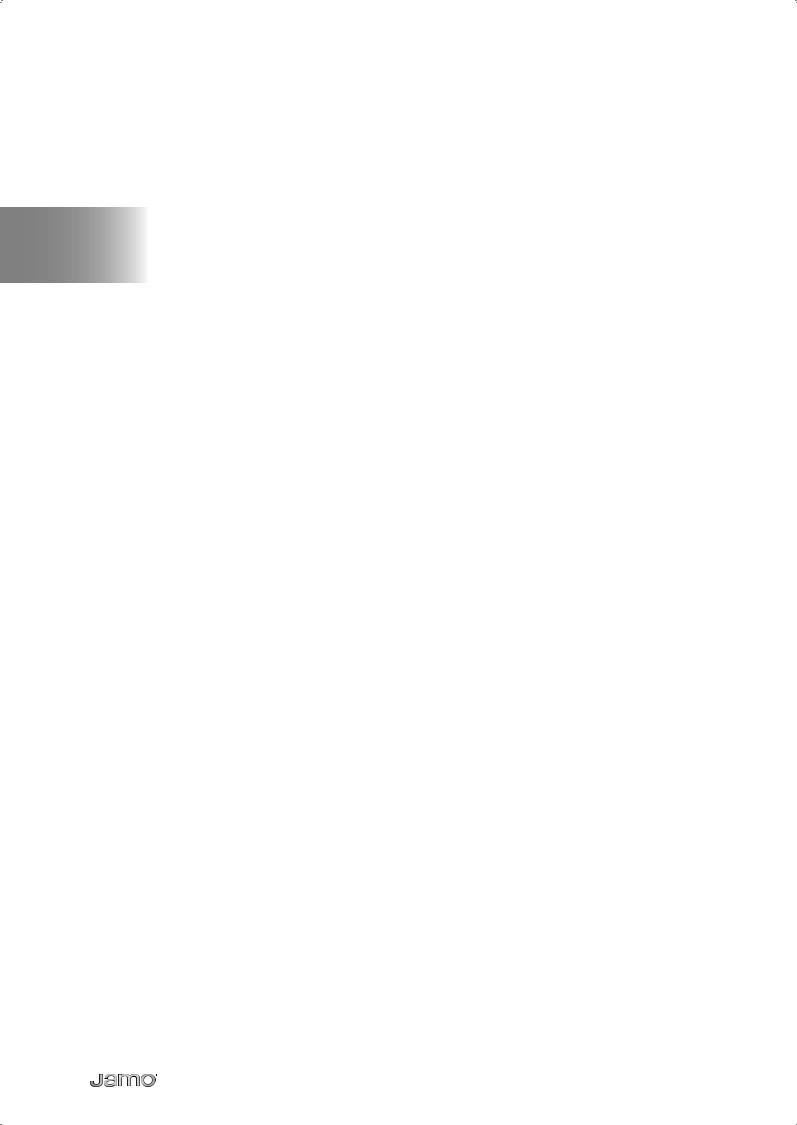
français |
Sommaire |
|
|
Introduction ...................................................................................................................................... |
5 |
|
Quelques conseils concernant l’installation des enceintes ............................................. |
6 |
|
Connexion.......................................................................................................................................... |
8 |
|
Pointes................................................................................................................................................. |
9 |
|
C 803 / C 805 / C 807 / C 809 ..................................................................................................... |
10 |
|
C 80 CEN ........................................................................................................................................... |
11 |
|
C 80 SUR............................................................................................................................................ |
12 |
|
C 80 SUB............................................................................................................................................ |
14 |
|
Connexion du caisson de grave ............................................................................................... |
15 |
|
Bornes d’entrée de niveau des enceintes............................................................................. |
16 |
|
Options de réglage du caisson de grave .............................................................................. |
17 |
|
Nettoyage ........................................................................................................................................ |
19 |
|
Spécifications.................................................................................................................................. |
20 |
|
Jamo consumer warranty........................................................................................................... |
21 |
4
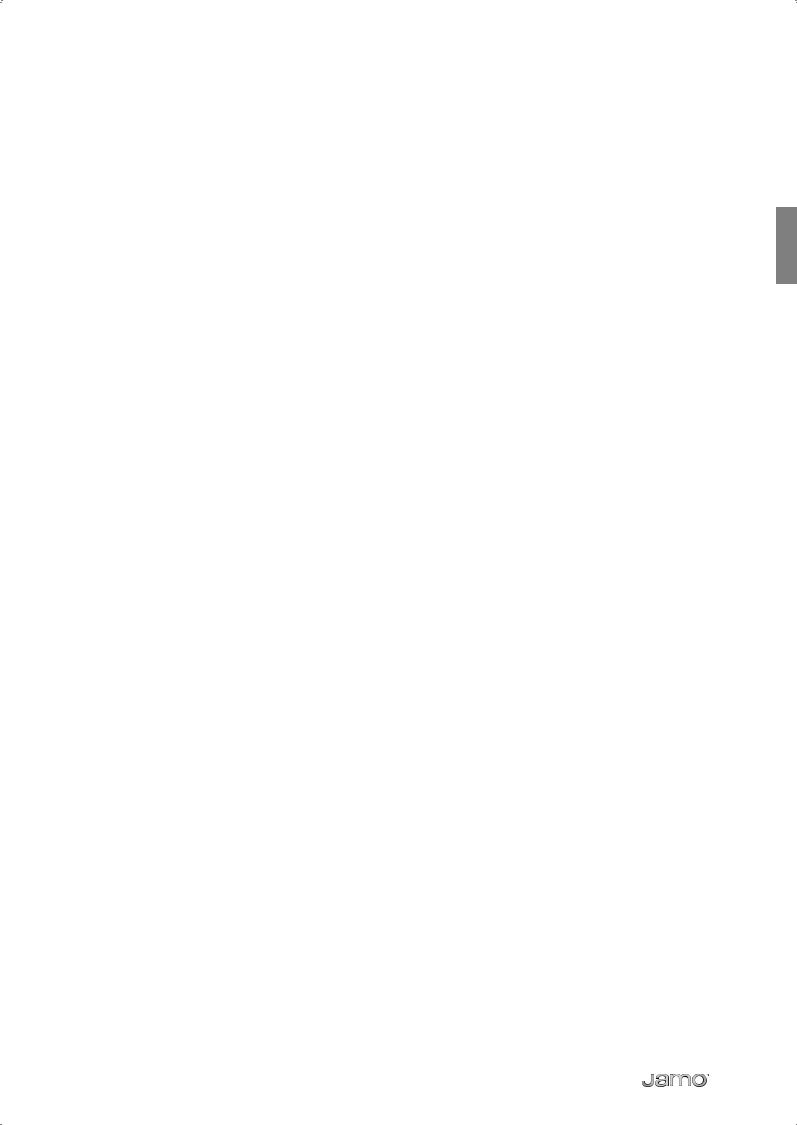
Introduction
Bienvenue dans le cercle très privé des utilisateurs de l’enceinte Jamo C 80 ! Ce manuel vous donnera des conseils concernant l’installation des enceintes dans votre pièce. Pour des informations plus détaillées sur les technologies utilisées, veuillez vous reporter à la description technique de l’enceinte C 80 et visiter notre site www.jamo.com.
Un conseil pour commencer : après la toute première installation de vos enceintes, laissez passer quelques jours avant de procéder au réglage précis du son. Cela aura deux conséquences importantes. Tout d’abord, vous aurez une meilleure idée de la puissance de ces enceintes. Ensuite, cela permettra aux enceintes de se roder : la qualité des tons de ces enceintes change légèrement après quelques jours d’utilisation.
Souvenez-vous que les conseils donnés dans ce manuel ne sont que de simples recommandations. Il n’existe aucune règle stricte et immuable concernant l’installation des enceintes. Lors du réglage des performances dans votre pièce, n’ayez pas peur de faire plusieurs essais : les enceintes émettent un son différent à chaque fois qu’elles sont déplacées, même de quelques centimètres. N’hésitez donc pas à les changer de position et à les déplacer à travers la pièce afin de trouver la meilleure position d’écoute et le meilleur son.
Faites toujours confiance à votre propre ressenti. C’est ce que nous faisons…
Bonne écoute !
5

Quelques conseils concernant l’installation des enceintes
Stéréo « triangle »
La stéréo « triangle » peut tout à fait être utilisée de manière empirique, lors du placement de vos enceintes. Cela signifie que la distance entre les enceintes doit être identique à celle entre votre position d’écoute et chacune des enceintes ; en d’autres termes, ces trois éléments doivent constituer un triangle équilatéral.
Isolation
Si votre pièce…
a)ne vous permet pas de placer les enceintes à la distance requise des différents murs ou…
b)possède des surfaces très réfléchissantes (comme des vitres ou des murs en plâtre nu) ou…
c)n’émet pas le son attendu…
… nous vous recommandons fortement d’« isoler » les surfaces critiques de votre pièce, en ajoutant par exemple des rideaux, des meubles, des étagères, etc. Une surface isolée est presque toujours préférable à une surface trop réfléchissante.
En fonction de la position des enceintes, de la taille de la pièce, des surfaces réfléchissantes, des meubles, etc., c’est à vous de régler au mieux la position, l’angle et l’isolation. Prenez votre temps et n’hésitez pas à faire plusieurs essais.
6

Convergence
Pour obtenir un son optimal, les enceintes peuvent être orientées en direction de la position d’écoute. Cela permet:
a)Un réglage précis des aigus, plus sensibles aux réflexions que les fréquences médiums et basses.
b)Des réflexions minimisées des murs latéraux, réduisant ainsi la coloration du son.
Il se peut que certains ne souhaitent pas du tout faire converger les enceintes, alors que d’autres peuvent considérer que la meilleure solution consiste à les orienter directement vers la position d’écoute. À vous de choisir ce qui vous convient le mieux…
7
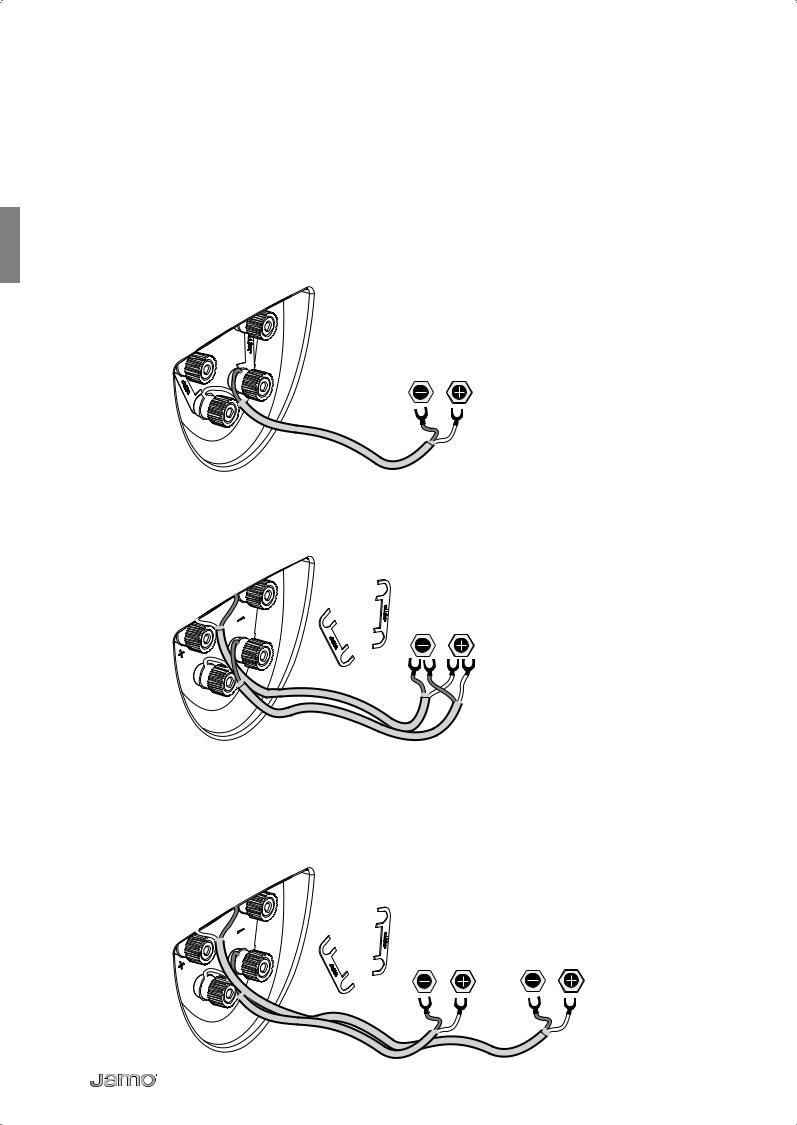
Connexion
Les enceintes C 803, C 805, C 807 et C 809 sont prévues pour utiliser un double câblage.Voici les trois installations possibles.
Simple câblage
Pour les connexions à câble unique, les fils de raccordement doivent être connectés comme indiqué sur le schéma.
AMPLIFIER
Double câblage
Si vous souhaitez utiliser un système à double câblage, assurez-vous de bien retirer les deux fils de raccordement avant de connecter les câbles des enceintes…
AMPLIFIER
Double amplificateur
Dans un système à double amplificateur, assurez-vous de bien retirer les deux fils de raccordement avant de connecter vos câbles, comme indiqué sur le schéma.
Si vous choisissez cette option, nous vous conseillons d’utiliser des amplificateurs identiques afin de contrôler à la fois les fréquences basses et aigues.
AMPLIFIER 1 |
AMPLIFIER 2 |
8

Pointes
Après le placement initial des colonnes C 80, vous souhaiterez peut-être utiliser des pointes, et non les supports en caoutchouc intégrés. Pour les fixer, nous vous conseillons de poser délicatement l’enceinte sur le côté et de visser les quatre pointes en même temps. Avant cela, cependant, veillez à placer un linge épais sous l’enceinte afin d’éviter toute rayure accidentelle sur la surface de l’enceinte.
2
1
Après avoir vissé les pointes, redresser délicatement l’enceinte. Une fois à la verticale, il vous suffit de régler les pointes, de manière à ce qu’elles fournissent un support optimal.
Les pointes vous procureront le meilleur support et la meilleure qualité sonore. Cependant, si vous souhaitez éviter de marquer votre sol, vous pouvez placer les rondelles métalliques à dentelures sous la pointe.Les pieds intégrés en caoutchouc sont également un bon compromis. Pour ce qui est du son, il n’y a vraiment qu’une différence minime entre les deux. Utilisez la solution qui convient le mieux à votre sol.
Avertissement : lorsque vous utilisez les pointes associées aux rondelles métalliques à dentelures, prenez garde à ne vous pincer les doigts entre les deux !
Quelle que soit l’option que vous choisissez, si vous devez déplacer les enceintes, évitez de les faire glisser… surtout sur des planchers !
9

C 803 / C 805 / C 807 / C 809
Placement
Pour une écoute optimale, nous vous conseillons de placer les enceintes à 2 mètres minimum l’une de l’autre, à 0,5 mètre minimum du mur arrière et à au moins 1 mètre des murs latéraux.
-INM FT |
-INM M FT |
-IN FT |
|
10

C 80 CEN
Placement
Pour une écoute optimale, nous vous conseillons de placer la C 80 CEN à proximité de votre écran, au dessus ou en dessous. L’enceinte est protégée magnétiquement et peut donc être placée à proximité d’un téléviseur normal à tube cathodique.
Assurez-vous que le support de la C 80 CEN est le plus stable possible, ce qui garantira un son optimal.
Angle
Pour un son optimal, le support fourni est fabriqué de manière à pouvoir orienter la C 80 CEN directement vers votre position d’écoute. Essayez différents angles jusqu’à obtenir entière satisfaction.
Connexion
Amplifier
11

C 80 SUR
Placement
La C 80 SUR est équipée du système XBR (réponse en basses fréquences étendue), ce qui signifie qu’elle fonctionne comme une enceinte dipolaire pour les fréquences aigues et médiums, et comme une enceinte bipolaire pour les plus basses fréquences. Cela permet une restitution sonore Surround diffuse, typique des enceintes dipolaires traditionnelles, tout en reproduisant intégralement les fréquences basses. À cause de cette configuration dipolaire, les enceintes gauche et droite de la C 80 SUR sont conçues séparément.
La C 80 SUR restitue le meilleur son lorsqu’elle est orientée à 20° de la position d’écoute et qu’elle est placée à une hauteur d’environ 2 mètres.
Connexion
Amplifier
12

Installation d’un système 6.1 et 7.1
Si vous souhaitez installer un système 6.1 Surround, nous vous conseillons d’utiliser une enceinte C 80 SUR (gauche) supplémentaire.
Placez-la à égale distance des deux murs latéraux, derrière votre zone d’écoute, et vous obtiendrez un son optimal.
Dans un système 7.1, utilisez deux enceintes C 80 SUR et placez-les à une distance égale au quart de la largeur de la pièce, à partir de chaque mur latéral.
Remarque : lors du placement de l’enceinte C 80 SUR utilisée comme enceinte arrière Surround, vous devez placer la C 80 SUR (gauche) du côté droit de la pièce, et vice versa, afin d’obtenir une dispersion correcte des enceintes dipolaires.
13
